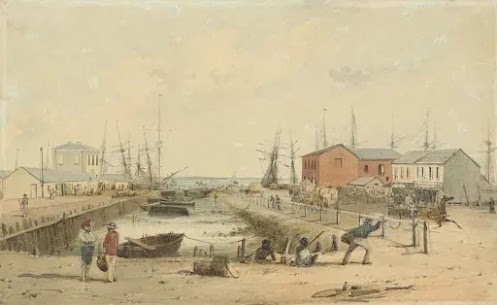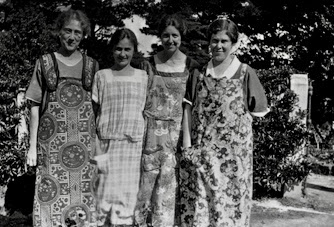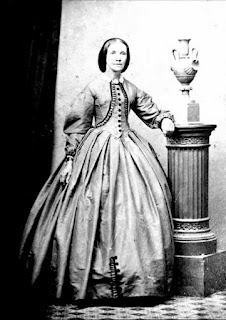29/52 Fun Fact: Mary Elizabeth Jackson, 1852 -1913
29/52 Fun Fact. Mary Elizabeth Jackson, 1852 -1925
My mother’s married name was Mary Jackson. I decided to have a look in my tree and see how many Mary Jacksons there were. Fun fact: there were six. The first four were all connected to my father’s family. But the last two were not. This week I am going to follow up Mary Elizabeth Jackson, related to the Hunt family.
Mary Jackson’s mother was Maria Hunt - not the Maria Anne Hunt who was my great grandmother. This Maria Hunt was actually the younger sister of my great grandmother’s grandfather.
William Hunt - Mary Sadler
l
—————————————————————————
l l
Solomon m Mary Austin -siblings- Maria m James Jackson
l l
William m Elizabeth Ann Best -cousins- Mary Elizabeth Jackson
(1844) l (1852)
Maria Anne m Brian Wibberley - cousin once removed
(1867) l
Brain Wibberley m Margery Godlee- cousin twice removed
l
Mary Wibberley m Ted Jackson - cousin 3x removed
l
me - cousin 4x removed
So that makes Mary Elizabeth Jackson the first cousin of William Hunt, the Primitive Methodist missionary, Mary’s mother, Maria, was William Hunt’s aunt but because Maria was so much younger than Solomon, the aunt is the almost the same generation as her nephew. Mary Jackson is my first cousin 4 times removed.
Maria and Solomon Hunt were children of agricultural labourers, William and Mary née Sadler, in Wiltshire. Solomon was older than Maria by 15 years, he being the oldest and she the second youngest. Maria was born in July in 1826 in Broad Hinton, Wiltshire and baptised in the Anglican Church. Except for Solomon, who had a business in trading in china and glass, they were agricultural labourers who couldn’t sign their name when they married. Sister Ann married a ‘rag gatherer’ who became a ‘licensed hawker’.
Maria married James Jackson in April, 1851. She was 24 and he was 26. His father and mother could sign their names on their marriage certificate and in 1851 his father worked as a tax collector. In the 1851 Census Maria was a servant at her brother Solomon’s house. He and his wife, were active Primitive Methodists so I wonder if she became one too at that time. Does that mean they could read the Bible?
Two of the Hunt siblings appear to have migrated, Richard, the second eldest may have died in Canada. Maria and James Jackson set sail from Liverpool on the 10th of June, or from Plymouth the 16th, for South Australia on the Reliance, an 805 ton vessel. On July 27th, James Jackson died from diarrhoea and was buried at sea.’ A note on the shipping records says:
The Reliance tried the great circle sailing, and found it advantageous, having been, on July 30th, in lat. 27° 55' S, and long. 32° 31' W, and made Kangaroo Island on the 11th September ; doubling the Cape on 14th August, in lat 51°, and the highest latitude being 64° south.
This tells us that James Jackson died somewhere in the Atlantic Ocean, about the latitude of Brazil. I’ll bet Maria was wishing she’d never left Wiltshire. There were 19 deaths at sea, 10 of them infants. The newspaper report in the Adelaide Times refers to the high number of deaths and wonders if it is connected to the 338 tons of patent fuel they were carrying and says ’It will of course have to be enquired into by the Health Officer and the Emigration agent.’ ‘Patent fuel’ was some kind of coal based fuel which emitted poisonous gases.
Overwhelmingly the 313 Government Emigrants on board the Reliance were agricultural labourers, although the single women were all servants. There were quite a few miners going to the copper mines in SA and to the Victorian gold fields.
http://www.theshipslist.com/pictures/ondeck.shtml
Maria Jackson arrived in Port Adelaide on the 15th of September. She was pregnant. 280 ships arrived in Adelaide that year. Just about all the able bodied men in Adelaide were heading east to make their fortune in gold. In October the Adelaide Destitute Relief Board announced that they would not maintain the families of men who had left for the diggings. I wonder if they did help the widows of agricultural labourers newly arrived in the colony. What could Maria do? I guess she could join the single women on the Reliance who would be looking for work as servant girls.
https://www.britannica.com/place/South-Australia/History
Her daughter was born on the 27th of February, 1852, in Adelaide and was named Mary Elizabeth. Mary was for Maria’s mother, Mary Sadler. Since looking into Mary Jackson I find on other people’s Ancestry records that it says ‘Mary Elizabeth ‘Lizzie’ Jackson’ So that’s a ‘fun fact’! I go looking for a Mary Jackson and I find one called ‘Lizzie’.
In 1853 Maria married again: Charles Edward King. He was younger than Maria, from Aylesbury, Buckinghamshire. A Charles King, agricultural labourer. arrived in April 1852 on the Caucasian but he is listed as aged 28 so I question if it is the same Charles King. Possibly Charles’ age on the Caucasian is wrong. Further apparently the marriage took place in his home in Morphett Vale and if he had only arrived, an agricultural labourer, it seems unlikely that he would have a home already by 1853. However, Charles did have an older brother, Thomas Layton King, who lived in Morhpett Vale, so perhaps the wedding took place here. Thomas is referred to in his son’s 1937 obituary as ‘one of the oldest pioneers of the district’. I have not been able to find out which ship Thomas or Charles came on but Thomas had his first South Australian child in 1852 and must have come after he married in England in 1846.
Either way, Charles King and Maria married in Morphett Vale and went on the have thirteen children: six girls survived and three boys. At that time Morphett Vale was like a rural village outside Adelaide and they probably farmed wheat or wine grapes. A new school was opened in 1854, called Victoria School - after the Queen, and hopefully our Mary was able to attend. In 1855 ‘forty two well dressed boys and girls’ were examined in various branches of learning,: ‘viz reading, spelling, writing, arithmetic, simple and compound, geography (particularly of the Australian colonies and the adjacent islands,) English grammar, etymology, including the principle of derivation.’ The Inspector complimented the parents and trustees and added ‘that the people of Morphett Vale ought to be very proud of their children and their children’s teacher’.
In 1864 it was reported that the Primitive Methodists of Morphett Vale had been meeting at the home of Charles E King, but were planing to build a church and Sunday School. After searching endlessly for references to Charles, and drawing blanks, to find this reference to holding Primitive Methodist meetings in his home was welcomed like manna from Heaven. I found it by researching the school in Morphett Vale. He was also elected as a local government councillor in Morphett Vale.
In 1870 the Kings moved to Georgetown. Maria’s last three babies were born here and all of them died. Georgetown was a new settlement.
The Georgetown township survey made in 1869 was on a grand scale. The town, located in open grassy country, extended over 2235 hectares and was planned as a miniature Adelaide, with north, south, east and west terraces. At first Georgetown flourished with settlement and businesses; but its prosperity declined when, as a result of political pressures, the railway line at first proposed to pass through Georgetown and Narridy was diverted to run through Jamestown and Caltowie to Port Pirie.
Rhona, the last of Maria’s babies, was recorded as born at Gulnare, an independent township near to Georgetown. Probably the Kings were wheat farmers as this was the reason the area was opened up for settlement, providing wheat to the Victorian market. in the Northern Councils, History web site it says:
The real pioneering settlers came in 1873, when the Government introduced a deferred credit payment scheme. Buyers paid 1 pound an acre (0.4 hectare) for land. These men toiled under very hard conditions to transfer virgin country into fertile and arable land. Meat was so scarce that the settlers often ate wild goat from the herds that proliferated on the hills of Bungaree run.
Charles King died in 1888. The older King girls, Maria, Sarah, Rebecca Eliza, all married at their father’s home in Georgetown. Annie King, the eighth child, married at ‘Res of the Bride’s Mother of Bundaleer’ in 1895. Bundaleer is very close to Gulnare and Georgetown, so that was probably their family home.
We don’t know where Mary Jackson was during this time but I imagine that she may have stayed at home, unpaid help and companion for Maria. All the King children married and most of them moved away from Georgetown.
Maria lived until 1913 dying at 87 in Henley Beach. The forth child Rebecca King, married Thomas Charles Hynes and he died also in Henley Beach in December 1913. This suggests that Maria was at Rebecca’s place when she died on October 20th. Mary Jackson was 61 when her mother died.
Mary’s death notice in three Adelaide papers said on 19 Sept 1925 reads:
On the 10 August, at the residence of her sister (Mrs Quin, Galston, NSW.) Mary Elizabeth Jackson, aged 73 years and six months. Daughter of the late Mrs C. E. King, Georgetown. and of James Jackson, who died at sea, 1851.
This sister was Emma, who was 16 years younger than Mary, the youngest of Maria’s children.
This is a pretty unsatisfactory ‘fun fact’. I found six relations with the name of Mary Jackson. I chose my cousin who was born in Adelaide in 1851, her father having died at sea. Her mother remarried and had many children but I have not found out anything about Mary Jackson, only that she was called ‘Lizzie’ and died at 73 in the home of her half-sister, in NSW. She lived to see women get the vote but she is not on the electoral roll. Except for her death notice, she doesn’t appear in Trove. She had a big family of step brothers and sisters who all got married. She did not. It would be good to have discovered a ‘fun fact’ like she ran away to join a circus. but sadly, I think she probably led an unremarkable life as so many women did. I imagine her life was confined to domestic service at home and perhaps involvement in the Methodist church the high points being the church bazaar and the Sunday School anniversary.





Comments
Post a Comment